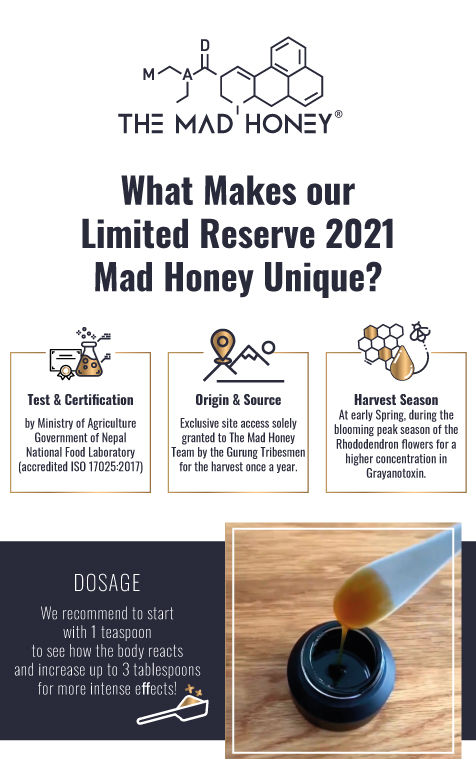
Herkunft & Einzigartigkeit

Unser Himalaya Honig (Mad Honey) stammt aus den entlegenen Hochlagen Nepals – über 3.000 Meter hoch, wo wilde Honigbienen ihre Waben an steilen, unzugänglichen Felsklippen bauen. Diese außergewöhnliche Region ist nahezu unerreichbar, und wir sind das einzige Unternehmen mit offiziellen Genehmigungen, um dieses exklusive Sammelgebiet direkt zu betreten.
Dank dieser besonderen Genehmigung können wir nur einmal pro Jahr ernten, was Ihnen höchste Qualität und maximale Potenz garantiert.

Einmalige Jahresernte – nur im Frühling
Die Ernte findet nur einmal im Jahr, im Frühling, statt – genau dann, wenn die Rhododendron-Blüten ihren Höhepunkt erreichen. Die einzigartige Flora dieser Region liefert den seltenen Nektar, den die Bienen sammeln. Unsere limitierte Ernte und die sorgfältige Arbeit der lokalen Sammler schaffen einen Honig mit unverwechselbarer Tiefe, Charakter und besonderen Eigenschaften!
Was macht unseren Honig einzigartig?
Extrem selten: Nur eine Ernte pro Jahr und ausschließlich aus unserem exklusiven Zugangsgebiet.
Wild gesammelt: Frei lebende Bienen, natürliche Vegetation, minimal verarbeitet – das Ergebnis ist ein authentischer, Psychoaktiver Honig mit außergewöhnlichem Profil.
Höchste Potenz: Durch die einzigartige Höhenlage, die spezielle Rhododendron-Flora und die Riesenbienen entsteht ein Produkt, das sich deutlich von herkömmlichem oder anderem „Mad Honey“ unterscheidet.

Versand nach Europa
Wir bieten kostenlosen Standardversand für alle Bestellungen (durchschnittliche Lieferzeit 5–8 Werktage, keine zusätzlichen Gebühren, keine Steuern, keine Zollabwicklung) sowie UPS Express-Versand mit einer Lieferzeit von nur 2 Tagen nach Deutschland. Nutzen Sie unser Oktober-Angebot mit kostenlosem UPS Express-Versand bis Ende Oktober 2025!

Genuss & Anwendung
Dieser Honig ist kein gewöhnlicher Frühstückshonig!
Seine seltene Herkunft und besondere Zusammensetzung machen ihn zu etwas wirklich Außergewöhnlichem. Ob als Highlight für bewusste Genussmomente oder als inspirierender Begleiter – unser Produkt ist für alle, die das Besondere suchen.

Warum genau unser Mad Honey?
Viele Anbieter werben mit Begriffen wie „Himalaya Honig“, „Cliff Honey“ oder „Wilder Honig“ – doch nur wenige können echte Reinheit, Herkunft, limitierte Ernte und exklusive Sammelrechte nachweisen.
Wir können es!
Unser Honig stammt aus einem Gebiet, das wir selbst ausgewählt haben – ein echtes Premium-Erlebnis, direkt aus den Waben ins Glas – roh und unpasteurisiert, das ultimative Geschenk der Natur

Versand & Lieferung
Mad Honey Deutschland: wir legen größten Wert darauf, dass Ihr Paket sicher und schnell bei Ihnen ankommt:
Kostenloser UPS Express-Versand in alle EU-Länder bis Ende Oktober 2025 (Lieferzeit nach Deutschland: ca. 2 Tage)
Sichere Verpackung in Glasgläsern, um die außergewöhnliche Qualität zu bewahren
Fazit
Wenn Sie auf der Suche nach einem Mad Honey sind, der weit über das Alltägliche hinausgeht, ist unsere “Limited Rserve” mit ihrem echten Premium-Charakter genau das Richtige. Entdecken Sie ein Naturprodukt, das buchstäblich aus den Höhen des Himalaya stammt und mit seiner Seltenheit und Qualität begeistert.
Tauchen Sie ein in ein außergewöhnliches Erlebnis und lassen Sie sich von der Kraft der Natur inspirieren – auf völlig neue Weise.
Namaste – wir freuen uns auf Ihre Bestellung! 🙏






















